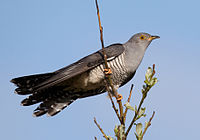
Photo from wikipedia
Pine seeds are known for their richness in lipid compounds and other healthy substances. However, the reference procedures that are commonly applied for their analysis are quite laborious, time-consuming, and… Click to show full abstract
Pine seeds are known for their richness in lipid compounds and other healthy substances. However, the reference procedures that are commonly applied for their analysis are quite laborious, time-consuming, and expensive. Therefore, it is important to develop rapid, accurate, multi-parametric, cost-effective and, essentially, environmentally friendly analytical techniques that are easily implemented at an industrial scale. The viability of using near-infrared (NIR) spectroscopy to analyse the seed lipid content and profile of three different pine species (Pinus halepensis, Pinus brutia and Pinus pinaster) was investigated. Moreover, species discrimination using NIR was also attempted. Different chemometric models, namely partial least squares (PLS) regression, for lipid analysis, and partial least square—discriminant analysis (PLS-DA), for pine species discrimination, were applied. In relation to the discrimination of pine seed species, a total of 90.5% of correct classification rates were obtained. Regarding the quantification models, most of the compounds assessed yielded determination coefficients (R2P) higher than 0.80. The best PLS models were obtained for total fat, vitamin E, saturated and monounsaturated fatty acids, C20:2, C20:1n9, C20, C18:2n6c, C18:1n9c, C18 and C16:1. Globally, the obtained results demonstrated that NIR spectroscopy is a suitable analytical technique for lipid analysis and species discrimination of pine seeds.
Journal Title: Foods
Year Published: 2022
Link to full text (if available)
Share on Social Media: Sign Up to like & get
recommendations!